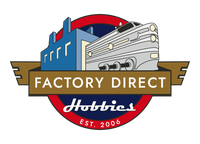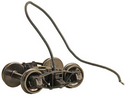New Page 1These trucks are made from High Gravity Compound, HGC that weighs nearly
the same as metal trucks, while allowing for a more detailed part. A two piece
split bolster design for more efficient truck equalization and reduced axle
friction for greater rolling performance. The Self-Centering Action allows the
trucks to self align parallel with the car for easier placement on track. Our
Caboose Pickup Trucks come with Metal RP-25 Code 110 wheels, scale clip on brake
pads & brake rigging.
Truck Features
Code 110 (.110 wide) 33" smooth back wheels
"HGC" High Gravity Compound Weighs nearly the same as Metal Trucks
Superior Rolling Ability.
Brake Pads
Accurate markings
Incredible detail True to prototype
Non-magnetic Metal Wheels
Highly Flexible Fully Equalized Trucks
Smooth tracking Free rolling Contoured Insulated Axles
RP-25 Free rolling wheels
26 AWG wire, max. amps 250 mA.
Made in the U.S.A.
Patent number 7,434,518 B2
Self Centering Action - Trucks self align themselves parallel with the car for
easier placement on track.
Electrical Pickup Caboose Truck Installation.
1. From the center of the pivoting point of the truck measure 3/16 back toward
the center of the car and drill a 5/32 hole through the floor. Some
under-frames may require a different hole location but try to get it as close to
the 3/16 as possible. Also, some cars may have a metal floor or weight that
youll have to drill through or remove.
2. Remove all the sharp edges from the hole so there is nothing to scrape or cut
the wire.
3. To make the proper electrical connection mount the trucks making sure the red
dots on the bottom are on opposite sides. The red dot indicates the hot side or
the side that picks up the current.
WARNING: If the trucks are not orientated correctly it will cause an electrical
short.
4. Make sure the trucks rotate freely and the wires are through the holes
without knots or kinks. Leave enough slack in the wire leads so the trucks can
pivot and wires can move unhindered.
5. Attach the leads to your lighting unit according to your requirements using
basic electrical connecting methods.
If needed only use a Dry Graphite Lubricant such as KadeeÃÃÃÃÃÃÃÃÃÃÃÃÃÃÃÃÃÃÃÃÃÃÃÃÃÃÃÃÃÃÃÃÃÃÃÃî #231 Greas-em.
The term Code 110 and Code 88 relates to the width of the wheels and has no
relationship to track code. Code 110 wheels are .110" wide and Code 88 are .088"
wide. Code 110 wheels are the common (or "Standard") width wheels and Code 88
are what is called "Semi-Scale" and are used when the modeler wants a more
prototypical looking wheel width. Actual HO-Scale prototypical wheel width would
be around .067" wide and although they will run OK on the average track they
will not go through common turnouts and crossings. Code 88 (.088") is just about
the minimum width of wheel that will run on most standard or common track if
gauged correctly. It really is a matter of appearances because there's very
little operational differences between running Code 110 or Code 88 wheels. Code
88 wheels look really good and are most noticeable on open frame cars like
hoppers and tank cars. However, they also look great on boxcars, gondolas, and
reefers but not quite as noticeable. As mentioned above track code and wheel
code have no relationship meaning Code 110 and Code 88 will run on most any code
of track. Track code is simply the measured height of the rail, code 100 is
.100" tall, code 83 is .083" tall, code 70 is .070" tall, and so on.



